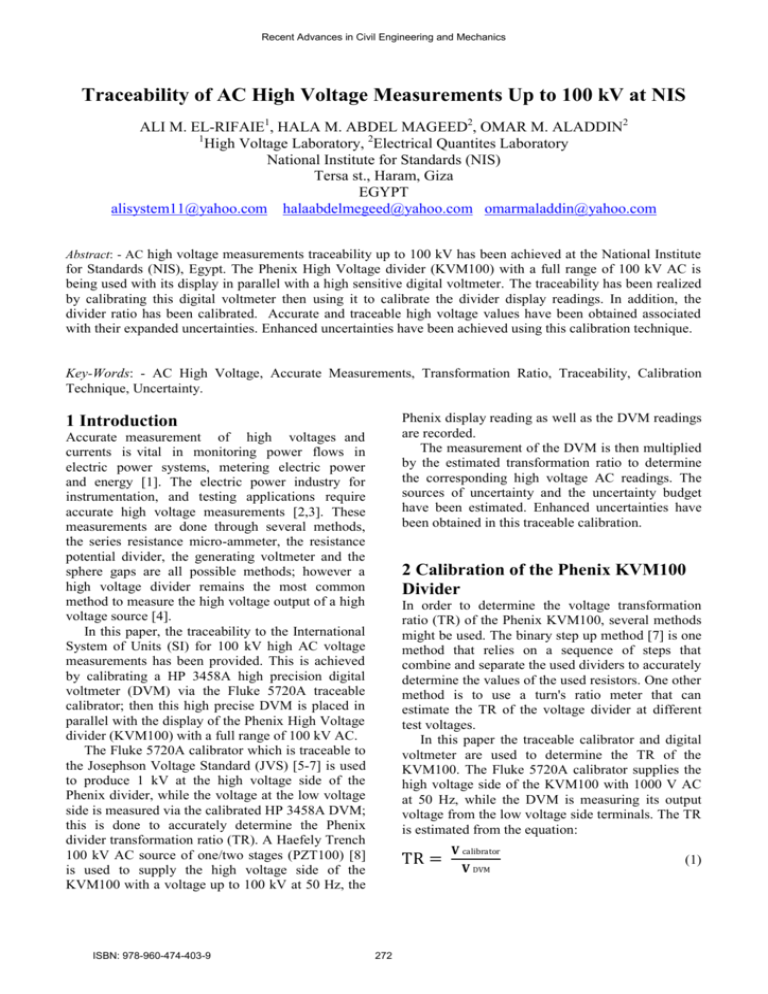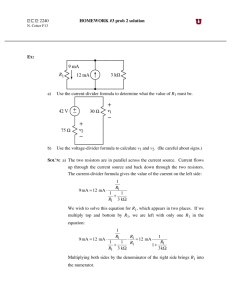Traceability of AC High Voltage Measurements Up to 100 kV at NIS
advertisement

Recent Advances in Civil Engineering and Mechanics Traceability of AC High Voltage Measurements Up to 100 kV at NIS ALI M. EL-RIFAIE1, HALA M. ABDEL MAGEED2, OMAR M. ALADDIN2 1 High Voltage Laboratory, 2Electrical Quantites Laboratory National Institute for Standards (NIS) Tersa st., Haram, Giza EGYPT alisystem11@yahoo.com halaabdelmegeed@yahoo.com omarmaladdin@yahoo.com Abstract: - AC high voltage measurements traceability up to 100 kV has been achieved at the National Institute for Standards (NIS), Egypt. The Phenix High Voltage divider (KVM100) with a full range of 100 kV AC is being used with its display in parallel with a high sensitive digital voltmeter. The traceability has been realized by calibrating this digital voltmeter then using it to calibrate the divider display readings. In addition, the divider ratio has been calibrated. Accurate and traceable high voltage values have been obtained associated with their expanded uncertainties. Enhanced uncertainties have been achieved using this calibration technique. Key-Words: - AC High Voltage, Accurate Measurements, Transformation Ratio, Traceability, Calibration Technique, Uncertainty. Phenix display reading as well as the DVM readings are recorded. The measurement of the DVM is then multiplied by the estimated transformation ratio to determine the corresponding high voltage AC readings. The sources of uncertainty and the uncertainty budget have been estimated. Enhanced uncertainties have been obtained in this traceable calibration. 1 Introduction Accurate measurement of high voltages and currents is vital in monitoring power flows in electric power systems, metering electric power and energy [1]. The electric power industry for instrumentation, and testing applications require accurate high voltage measurements [2,3]. These measurements are done through several methods, the series resistance micro-ammeter, the resistance potential divider, the generating voltmeter and the sphere gaps are all possible methods; however a high voltage divider remains the most common method to measure the high voltage output of a high voltage source [4]. In this paper, the traceability to the International System of Units (SI) for 100 kV high AC voltage measurements has been provided. This is achieved by calibrating a HP 3458A high precision digital voltmeter (DVM) via the Fluke 5720A traceable calibrator; then this high precise DVM is placed in parallel with the display of the Phenix High Voltage divider (KVM100) with a full range of 100 kV AC. The Fluke 5720A calibrator which is traceable to the Josephson Voltage Standard (JVS) [5-7] is used to produce 1 kV at the high voltage side of the Phenix divider, while the voltage at the low voltage side is measured via the calibrated HP 3458A DVM; this is done to accurately determine the Phenix divider transformation ratio (TR). A Haefely Trench 100 kV AC source of one/two stages (PZT100) [8] is used to supply the high voltage side of the KVM100 with a voltage up to 100 kV at 50 Hz, the ISBN: 978-960-474-403-9 2 Calibration of the Phenix KVM100 Divider In order to determine the voltage transformation ratio (TR) of the Phenix KVM100, several methods might be used. The binary step up method [7] is one method that relies on a sequence of steps that combine and separate the used dividers to accurately determine the values of the used resistors. One other method is to use a turn's ratio meter that can estimate the TR of the voltage divider at different test voltages. In this paper the traceable calibrator and digital voltmeter are used to determine the TR of the KVM100. The Fluke 5720A calibrator supplies the high voltage side of the KVM100 with 1000 V AC at 50 Hz, while the DVM is measuring its output voltage from the low voltage side terminals. The TR is estimated from the equation: (1) 272 Recent Advances in Civil Engineering and Mechanics Where VCalibrator is the actual value of the calibrator voltage and VDVM is the actual value of the average for 40 DVM voltage readings corresponding to the calibrator voltage. Figure 1 shows the block diagram for the Phenix divider calibration to estimate its transformation ratio. The temperature and relative humidity of the calibration laboratory have been adjusted and fairly controlled to (23±1)C 4 Results and Analysis The uncertainties of the calibration results of the DVM, the Phenix KVM100 divider and the Phenix KVM100 display results up to 100 kV AC have been investigated. The uncertainty is defined as the range of error of a measurement within which the true value of the measurand is estimated to lie within a stated level of confidence [9]. Type A and Type B evaluations are the two approaches to estimate the uncertainty sources. Type A evaluations of standard uncertainty components are founded on normal distributions, while type B evaluations are founded on a suitable chosen distributions. The combined standard uncertainty equals to the Root Sum Square (RSS), of all the uncertainty contributions [9,10] The uncertainty budgets have been evaluated for all calibrations. All components of the combined standard uncertainty (Type A and Type B) have been taken into consideration. The expanded uncertainty has been evaluated by using the coverage factor k = 2, to give a level of confidence of approximately 95% according to the ISO GUM [10,11]. The detailed uncertainty budget for calibrating the 100 kV at 50 Hz (as an example) has been listed in table 1. Table 2 illustrates the actual values of the AC voltages from 2 kV up to 100 kV at 50 Hz and their expanded uncertainties. Figure 3 shows the actual values of the Phenix readings with their expanded uncertainties. Although it seems that the expanded uncertainties increase with the increase of the voltage ranges their percentage values decrease. There is a degradation of the percentage uncertainties with respect to the voltage ranges to reach 0.01% from 80 kV to 100 kV. At lower voltage ranges the percentage expanded uncertainties are slightly higher but they don’t exceed 0.05%. It is clearly shown that very small uncertainty values have been achieved for high AC voltages using this calibration technique. Fig. 1: Block Diagram of Phenix divider calibration 3 Calibration of the Phenix KVM100 Display The Phenix KVM100 consists of a high voltage divider and 4 ½ digit LCD display (with both low and high voltage ranges). Its two main parts are connected by connecting cables. The calibrated HP 3458A DVM is used as a reference standard to calibrate the KVM100. The Phenix KVM100 divider is connected to the PZT100 AC source. Figure 2 illustrates the KVM100 Phenix calibration block diagram. By applying the calibrated TR, the actual values of the input high voltages from 2 kV to 18 kV (at the low range) and from 20 kV up to 100 kV (at the high range) have been acquired. Actual Values with their Expanded Uncertainties (kV) 100 96 92 88 84 80 76 72 68 64 60 56 52 48 44 40 36 32 28 24 20 16 12 8 4 0 Actual Values Expanded Uncertainties 2 4 6 8 10 12 14 16 18 20 30 40 50 60 70 80 Voltage Ranges (kV) Fig. 2: Phenix Calibration Block Diagram ISBN: 978-960-474-403-9 Fig. 3: Actual values of the Phinex readings 273 90 100 Recent Advances in Civil Engineering and Mechanics Table 1: Uncertainty Budget of Calibrating 100 kV at 50 Hz Uncertainty Sources Repeatability of the DVM readings Resolution of the DVM readings calibration certificate of the calibrator Repeatability of the calibrator readings Repeatability of the Phenix readings Resolution of the Phenix readings Standard Uncertainty Probability Distribution Divider Ci Uncertainty Contribution 9.48 E-03 V Normal 1 1 9.48 E-03 V 5.00 E-6 V Rectangular 3 1 2.89 E-6 V 1.30 E-5 V Normal 1 1 1.30 E-5 V 9.82 E-3 V Normal 1 1 9.82 E-3 V 4.72 V Normal 1 1 4.72 V 5.00 V Rectangular 3 1 2.89 V Combined standard uncertainty Effective degrees of freedom Expanded Uncertainty at confidence level 95%, (k = 2) ±5.53 V ∞ ±11.06 V Table 2: Actual values of the voltages from 2 kV to100 kV at 50 Hz and their expanded uncertainties Nominal Values (kV) 2 4 6 8 10 12 14 16 18 20 30 40 50 60 70 80 90 100 ISBN: 978-960-474-403-9 Measured Values (kV) 2.028 3.960 6.014 8.005 10.006 12.008 14.022 16.041 18.033 20.025 29.984 39.980 50.130 60.040 70.030 80.070 90.250 100.190 Actual Values (kV) 2.047 3.984 6.054 8.057 10.014 12.290 13.981 15.985 17.985 20.035 29.981 39.951 50.052 59.947 69.334 79.952 90.080 99.958 ±Expanded Uncertainty (V) 1.01 1.51 2.23 2.56 3.19 3.87 4.43 4.97 5.93 6.67 9.87 11.06 11.06 11.06 11.06 11.06 11.06 11.06 274 ±Expanded Uncertainty (%) 0.05 0.04 0.04 0.03 0.03 0.03 0.03 0.03 0.03 0.03 0.03 0.03 0.02 0.02 0.02 0.01 0.01 0.01 Recent Advances in Civil Engineering and Mechanics 5 Conclusion A new calibration technique has been used at NIS to disseminate the traceability to the high voltage AC measurements (up to 100 kV). The traceability to the SI units has been obtained. Measurements have been carried out using a high voltage meter (KVM100). The KVM100 divider and its display have been accurately calibrated. The actual values of the Phenix readings as well as calibration uncertainties have been calculated. The percentage expanded uncertainties for the voltage ranges from 2 kV to 100 kV don’t exceed 0.05% of their values. These percentage expanded uncertainties have been decreased to 0.01% at the higher ranges. Improved uncertainty results have been attained using this calibration methodology. [4] [5] [6] [7] References: [1] G.J. FitzPatrick and E.D. Simmon, "High voltage and current metrology at NIST. Precision measurements of the past, present, and the future," Annual Report Conference on Electrical Insulation and Dielectric Phenomena, 2001, pp. 277-280 [2] C.K. Dwivedi and M. B. Daigavane "Multipurpose low cost DC high voltage generator (60 kV output), using Cockcroft-Walton voltage multiplier circuit" International Journal of Science and Technology Education Research Vol. 2 (7), pp. 109 - 119, July 2011 [3] Guizhen Wang, QiutingJia and Gang Cao," A measurement method of high DC voltage" ISBN: 978-960-474-403-9 [8] Electrical & Electronics Engineering Symposium (EEESYM), 2012 J R Lucas, High Voltage Engineering - 2001, Chapter 11" High Voltage Direct Current Transmission," pp. 184-204 Hala M. Abdel Mageed, and Ali M. El-Rifaie, “Electrical Metrology Applications of LabVIEW Software,” Journal of Software and Engineering Applications, March 2013, pp. 113-120 Hala M. Abdel Mageed, and Ali M. El-Rifaie, “Electrical Quantities in Terms of the International System of Units,” Processing World Congress on Engineering 2013 Conference, 3-5 July, London, UK Sang Hwa Lee, Kwang Min Yu Jeon Hong Kang, MunSeog Kim, Kyu Tae Kim," A Josephson voltage-traceable DC high-voltage divider evaluation using the binary step-up method" Measurement 45 (2012), pp.488-492 http://www.haefely.com/pdf/LL_KIT.pdf Fluke Corporation, “Calibration: Philosophy in Practice,” 2nd Edition, Legal Department, Everett, WA 98206-9090, May 1994 [10] “The Expression of Uncertainty and Confidence in Measurement,” United Kingdom Accreditation Service, NA-MAS, M 3003, 1st Edition, January 2007. [11] Uncertainty Guide to the Expression of Uncertainty in Measurement, JCGM 100, 2008 [9] 275





